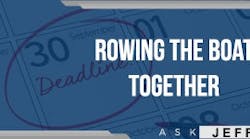Reeves, operations supervisor, KY
Answer: Reeves, we often talk about people as our greatest asset. They are. True to your statement, it appears we never have enough resources, especially given that many organizations run "lean." The challenge is how do we leverage all of our resources to improve our situation, specifically for asset reliability and availability, in this case. The definition of reliability is the capability of an asset to perform its intended function for a specified period. Studies show that engineering and operations own greater percentages of asset reliability versus the maintenance function alone. Therefore, reliability is not a “maintenance” thing. We must bust down the silos and leverage functional groups in partnership to drive improvements for the business holistically. We have to ensure that the maintenance house is in order, but we must all be headed in the same direction.
The question becomes, “Can we leverage our partners to drive reliability forward?”
Often when maintenance approaches operations, as an example, for help, we get lots of excuses as to why we can’t leverage their resources. You hear, “We’re short-staffed,” “We run lean,” or, “We can’t meet the production numbers now.”
Now for the controversy and, most likely, the reality in your organization. When the industrial engineers do time studies at plant sites, the results show that we only utilize operations personnel in direct work 25% to 75% of their time. They may be present at the equipment, listening and watching for production opportunities and performing checks, but that doesn't necessarily mean that they can’t be doing other things, too, rather than standing by for some event to occur.
Operators often outnumber the maintenance personnel by a factor of 5:1 or 10:1. Consider what would happen if we could leverage just 10% of an individual operator’s time, or 4 hours per week while he or she is operating the asset. Doing the math, at a ratio of just 5:1 operators per maintenance tech, we just gained 4 hours x 5 operators or 20 hours for run-time maintenance inspections. With a modest organization of 15 maintenance techs, that’s 20 hours x 15 technicians, or 300 available hours per week.
Consider that operators are with that equipment every day. They know how the equipment sounds, vibrates, and smells. With the correct expectations and training, they are the first line of defense for equipment failure. They can perform lubrication tasks, monitor process instrumentation for potential failure (P, as in the P-F curve), and carry out other tasks. When the equipment is not running, they can clean and perform minor maintenance tasks. Also, doing so allows them to become more intimate with their equipment and understand how it works and fails even better.
Round sheets are one application of this that comes to mind, but only if we identify the potential failure modes (the “P” of the P-F curve) on the sheet and couple it with instructions on what to do when the “P” is found. For example, the “P” on a transfer pump might be 110 GPM. When the process flowmeter indicates 110 GPM, the operator should be instructed to put in a work order to replace the impeller.
I’ll add that operators are craftspeople just like mechanics or electricians. We should have “operator” listed as a craft in the CMMS. We assign those run-time inspections to an individual operator just like we would with a maintenance mechanic.
What’s keeping you from leveraging operators to improve your reliability? If you are already doing this, what were the challenges you faced to make the effort a success?
Email me, and I will respond or place your questions with my answers here on "Ask Jeff."
Talk soon,
Jeff Shiver, CMRP


